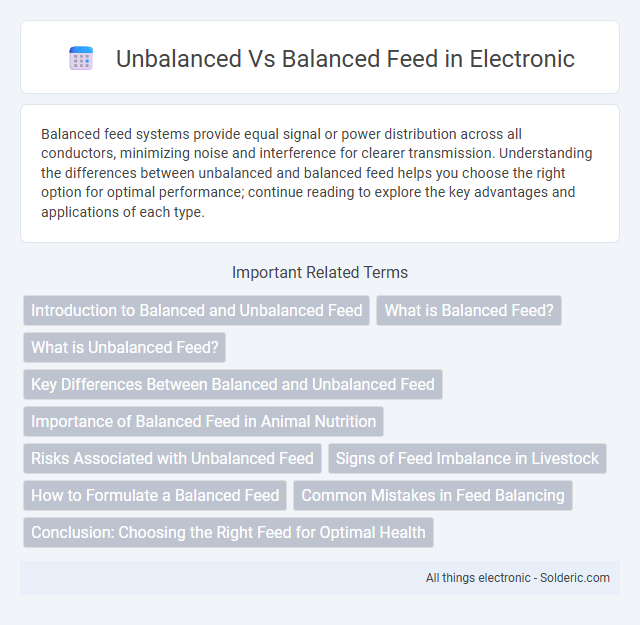Balanced feed systems provide equal signal or power distribution across all conductors, minimizing noise and interference for clearer transmission. Understanding the differences between unbalanced and balanced feed helps you choose the right option for optimal performance; continue reading to explore the key advantages and applications of each type.
Comparison Table
| Feature | Unbalanced Feed | Balanced Feed |
|---|---|---|
| Cable Type | Coaxial cable with single conductor and shield | Twisted pair cable with two equal conductors |
| Signal Quality | More susceptible to noise and interference | Better noise immunity and reduced interference |
| Common Usage | Consumer audio equipment, guitar cables | Professional audio, radio frequency transmission |
| Connector Types | RCA, TS (Tip-Sleeve) connectors | XLR, TRS (Tip-Ring-Sleeve) connectors |
| Signal Reference | Signal carried on one conductor, reference to ground | Signal carried on two conductors with equal and opposite voltages |
| Cost | Typically lower cost | Generally higher cost due to complexity |
| Distance Limits | Shorter distance without signal degradation | Longer distance with minimal signal loss |
Introduction to Balanced and Unbalanced Feed
Balanced feeds maintain equal voltage and current on both conductors, minimizing electromagnetic interference and signal loss. Unbalanced feeds use a single conductor with a ground reference, making them more susceptible to noise but simpler to implement. The choice between balanced and unbalanced feeds depends on factors like signal integrity, transmission distance, and environmental noise conditions.
What is Balanced Feed?
Balanced feed contains nutrients in precise proportions tailored to the specific dietary needs of livestock, ensuring optimal growth, health, and productivity. It includes a carefully measured mix of proteins, carbohydrates, fats, vitamins, and minerals that work synergistically to support metabolic functions and improve feed efficiency. Balanced feed reduces waste and minimizes nutritional deficiencies compared to unbalanced feed, which often lacks essential nutrients or has excesses that can harm animal performance.
What is Unbalanced Feed?
Unbalanced feed refers to a type of audio cable or connection where one conductor carries the signal while the other serves as a ground, which makes it more susceptible to noise and interference over long distances. This design is commonly found in consumer audio equipment using RCA connectors or standard 1/4-inch TS cables. You should consider balanced feed alternatives for professional environments where signal integrity and noise reduction are critical.
Key Differences Between Balanced and Unbalanced Feed
Balanced feed systems use two conductors carrying equal and opposite signals, minimizing electromagnetic interference and signal loss. Unbalanced feed employs a single conductor with a ground reference, which is more susceptible to noise and interference. Your choice between balanced and unbalanced feed impacts the signal quality, especially in environments with high electrical noise.
Importance of Balanced Feed in Animal Nutrition
Balanced feed provides essential nutrients in proper ratios, ensuring optimal growth, health, and productivity in animals. An unbalanced feed can lead to nutrient deficiencies, weakened immune systems, and poor overall performance. Your animals thrive when their diet is precisely formulated to meet specific nutritional requirements, preventing metabolic disorders and promoting longevity.
Risks Associated with Unbalanced Feed
Unbalanced feed can cause nutrient deficiencies or toxicities, leading to poor animal health and reduced productivity. Your livestock may experience digestive issues, weakened immune response, and impaired growth due to inconsistent nutrient intake. Properly balanced feed ensures optimal nutrient absorption, minimizing these risks and promoting overall well-being.
Signs of Feed Imbalance in Livestock
Signs of feed imbalance in livestock include poor weight gain, reduced milk production, and abnormal fecal consistency, which indicate nutrient deficiencies or excesses. You may also notice changes in behavior, such as increased aggression or lethargy, reflecting improper energy levels or mineral imbalances. Monitoring these symptoms closely helps ensure your animals receive a balanced diet for optimal health and productivity.
How to Formulate a Balanced Feed
Formulating a balanced feed requires precise calculation of nutrient requirements tailored to the specific needs of the livestock species, considering factors such as age, weight, production stage, and health status. Essential components must include a harmonious ratio of carbohydrates, proteins, fats, vitamins, and minerals to ensure optimal digestion, metabolism, and overall animal performance. Utilizing feed formulation software and consulting animal nutrition guidelines facilitate the creation of balanced diets that prevent deficiencies or toxicities often seen in unbalanced feeds.
Common Mistakes in Feed Balancing
Common mistakes in feed balancing include over- or underestimating nutrient requirements, leading to imbalanced rations that affect animal health and productivity. Inaccurate formulation often results from neglecting forage variability, improper mineral supplementation, and failure to consider life stage or production goals. Ensuring precise ingredient analysis and regularly updating feed formulations prevents nutrient deficiencies and excesses in both unbalanced and balanced feed regimes.
Conclusion: Choosing the Right Feed for Optimal Health
Selecting a balanced feed ensures optimal nutrient absorption and supports overall health, enhancing growth and immune function in animals. Unbalanced feeds often lead to deficiencies or toxicities that compromise metabolic processes and reduce productivity. Prioritizing balanced feed formulations tailored to specific species and life stages maximizes health outcomes and economic benefits.
unbalanced vs balanced feed Infographic

 solderic.com
solderic.com